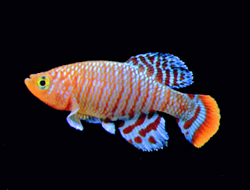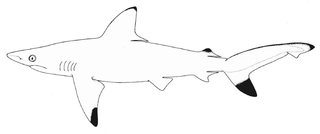
The term carp is a generic common name for numerous species of freshwater fish from the family Cyprinidae, a very large clade of ray-finned fish mostly native to Eurasia. While carp are prized quarries and are valued as both food and ornamental fish in many parts of the Old World, they are considered trash fish and invasive pests in many parts of Africa, Australia and most of the United States.

A killifish is any of various oviparous (egg-laying) cyprinodontiform fish, including families Aplocheilidae, Cyprinodontidae, Fundulidae, Nothobranchiidae, Profundulidae and Valenciidae. All together, there are 1,270 species of killifish, the biggest family being Rivulidae, containing more than 320 species. As an adaptation to living in ephemeral waters, the eggs of most killifish can survive periods of partial dehydration. Many of the species rely on such a diapause, since the eggs would not survive more than a few weeks if entirely submerged in water. The adults of some species, such as Kryptolebias marmoratus, can additionally survive out of the water for several weeks. Most killies are small fish, from 2.5 to 5 centimetres, with the largest species growing to just under 15 centimetres (6 in).

Nothobranchius is a genus of small, freshwater killifish, classified in the family Nothobranchiidae in the order Cyprinodontiformes. There are about a hundred species in the genus, many with very small distributions. They are primarily native to East Africa from Sudan to northern South Africa, whereas a dozen species are found in the upper Congo River Basin; the greatest species richness is in Tanzania.

The blue panchax or whitespot is a common freshwater fish found in a large variety of habitats due to its high adaptability. This species is native to southern Asia from Pakistan, India to Indonesia. It has been discovered in two hot springs in Singapore. Identified by a white-coloured spot on its head, the species can reach up to 9 cm (3.5 in) in length; it tends to keep to the surface of the water, and controls the mosquito population by feeding on their larvae.

The Pondicherry shark is an extremely rare species of requiem shark, in the family Carcharhinidae. A small and stocky gray shark, it grows not much longer than 1 m (3.3 ft) and has a fairly long, pointed snout. This species can be identified by the shape of its upper teeth, which are strongly serrated near the base and smooth-edged near the tip, and by its first dorsal fin, which is large with a long free rear tip. Furthermore, this shark has prominent black tips on its pectoral fins, second dorsal fin, and caudal fin lower lobe.

Aplocheilus is a genus of killifish in the family Aplocheilidae. Their native range is in South and Southeast Asia, from india to Vietnam and Malaysia, and from Nepal to Sri Lanka. Several species, especially the striped panchax, A. lineatus, are important aquarium fishes.

The striped panchax is a species of killifish, of the genus Aplocheilus. An aquarium variant of this species with a more yellowish coloration is known as golden wonder killifish. The striped panchax inhabits fresh and brackish waters of India and Sri Lanka. It is found in streams, rivers, swamps, and paddy fields. This fish grows to a length of 10 cm (4 in). Most male A. lineatus measure around 7 centimetres (3 in), but the fish can grow up to 10 centimetres (4 in) under excellent conditions, especially if brought to the end of its life expectancy, around 6 years. It possesses a parietal eye which permits it to see prey insects and predators above it on the surface. A. lineatus can jump very well.
The striped nothobranch is a species of freshwater fish of East Africa, belonging to the family Aplocheilidae.

The blue lyretail, also known as the Gardner's killi and formerly as the steel-blue aphyosemion, is a species of killifish. It is endemic to freshwater habitats in Nigeria and Cameroon.
The Ceylon killifish is a species of killifish endemic to Sri Lanka. This species grows to a length of 9 cm (3.5 in). Males and females have a black dot at the rear end of the base of the dorsal fin. The females lay 50–150 eggs. The specific name of this fish honours the Inspector-General of Fisheries in India Francis Day (1829-1889), who first reported this fish, although he identified it as Aplocheilus panchax.

Fundulopanchax is a genus of killifish living in near-coastal fresh water streams and lakes in Western Africa. All species were previously biologically classified as members of the genus Aphyosemion, with the exception of Fundulopanchax avichang, F. gresensi and F. kamdemi, which were all scientifically described after the major revision of the Aphyosemion complex.
Nimbapanchax is a genus of African rivulines, fish endemic to freshwaters in tropical West Africa.
Scriptaphyosemion is a genus of killifish from the family Nothobranchiidae which is endemic to Africa.
Saltwater fish, also called marine fish or sea fish, are fish that live in seawater. Saltwater fish can swim and live alone or in a large group called a school.

Austrolebias is a genus of killifish in the family Rivulidae. These annual killifish live in temporary pools, swamps and streams in the Río de la Plata, Patos–Mirim and Mamoré basins in South America.
Cynodonichthys is a genus of freshwater killifish in the family Rivulidae. They are found in Middle America, ranging from southern Mexico, through Central America, to Colombia. They are non-annual killifish and inhabit small forest streams from the lowlands to an altitude of 1,500 m (4,900 ft).

Aphyosemion bivittatum is a species of freshwater fish belonging to the family Aplocheilidae. It is found in rivers in southeastern Nigeria and southwestern Cameroon. It was originally described as Fundulus bivittatus by Swedish zoologist Einar Lönnberg in 1895. The holotype was discovered near a waterfall in the Ndian River in Cameroon and currently is located in the Stockholm Museum.

Nemipterus randalli, or Randall's threadfin bream, is a species of ray-finned fish from the family Nemipteridae, the threadfin breams, which is native to the western Indian Ocean and the Red Sea, it has invaded the eastern Mediterranean by Lessepsian migration through the Suez Canal.
Aplocheilus blockii or the green panchax is a species of fish native to waters around India, Sri Lanka, and Pakistan.
Tor barakae is a species of mahseer native to Manipur, India.












